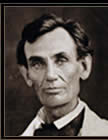by Claude N. Frechette, M.D.
discussion
There are two dissimilar points of reference, one of which concerns the angle the ear lobe forms with the neck. The angle is very small in the Kaplan but more open in all other Lincoln pictures. This is because of differences in body weight. The Kaplan Lincoln has a rounder face whereas the Meserve #1 and all other Lincoln pictures show a much thinner man with sunken cheeks. Using a laser copier, I artificially "aged" the Kaplan subject by darkening shadows. In this manner, I was able, visually, to "detach" the ear lobe from the neck, which made it identical to the other Lincoln likenesses. The other proportions of the ear are very similar: the antitragus (the small protuberance aft and below the larger tragus), shape of the lobe, posterior sulcus (lower portion of the opening of the ear), and the scapha.
Another concerns the height of the ascending branch of the mandible (where the jawbone turns upward). In prints of the Kaplan, the branch seems to be too short when compared with known Lincoln images. However, examination of the actual daguerreotype clearly shows that the up-turned collar is above the jaw, and is bent out and down. The collar is not under the mandible as it appears in prints made from the daguerreotype. The exact length of the jaw is outlined by a faint horizontal shadow that cannot be seen in the prints. The ascending branch of the mandible is actually longer than shown in the prints, and matches Lincoln's skeletal structure.
Abraham Lincoln was known to be extremely strong. The Kaplan daguerreotype shows a robust, barrel-chested, erect young man. The outline of the trapezius muscle (between the neck and shoulder) is evidence of a muscular build.
Lincoln experienced a radical weight loss in January, 1841. Mr. Volk, the maker of the Lincoln life mask, recalls that Lincoln said that he had again lost 40 pounds between 1858 and 1861 {11}.
The style of dress worn by the Kaplan subject is essentially identical to that which Lincoln kept during his entire life {4, 27, 28, 29}. The suitcoat worn by the Kaplan subject is so similar to the one Abraham Lincoln wears in the 1848 Meserve #1, it could be the very same suitcoat judging by the way the lapels, creases on a lapel, seams, and button holes match in both daguerreotypes.
Careful study of all Lincoln pictures clearly shows that he presented ptosis of both eyes. This condition also exists in the Kaplan. In the Kaplan, the left eye is slightly more ptotic than the right. A chronological study of Lincoln photographs reveals that ptosis appears to become more severe in the left eye later in life. The birth defect, congenital ptosis, existed in both of Lincoln's eyes from the beginning, but in its early stages, was probably not severe. His head injury contributed to an aggravation of the condition in the left eye. As time passed, aging, eyestrain, and a number of other factors amplified the ptotic condition in both eyes, manifesting itself increasingly in the more affected left eye {30}.
As Lincoln aged, his skin relaxed and forehead wrinkles became more pronounced. Vision in his left eye gradually became impaired. He inevitably developed the reflex of raising his left brow to relieve strain. This was described in a letter by Lincoln's law partner, William Herndon, as well as in photographs and observed by Kempf in the Volk life mask {11, 22, 23}.
Although the extent of his boyhood head injury may only be speculated on, it is probable that, in addition to the depressed skull fracture resulting from the fronto-temporal (forehead, close to the temple) trauma, he may have sustained a left orbital blow-out fracture {31, 32} (a fracture to the floor of the eye socket) and perhaps a superior orbital fissure syndrome {33} (paralysis of several voluntary and involuntary nerves to the eye), altering the position of the eye in its socket, and causing damage to the motor nerves in that region. These injuries would identify the source of all of Lincoln's post-natal eye problems.
French Police Assistance
In search of another viewpoint, I turned to the French police. Fortunately I was able to meet and work with authorities of the Identite Judiciaire, where I examined Alphonse Bertillon's original early 1890's publications that deal with criminal identity utilizing photographs {34, 35}. His system was the first scientific method of criminal identification {36}. Numerous celebrated crimes were solved using his classification of facial characteristics and anthropometrics. (Although a highly effective criminal identity technique, it was relegated to the background when the same M. Bertillon introduced fingerprint identification in France.)
Bertillon attached a great deal of importance to the structure of the ear, and also to that of the upper eyelid, having determined that these two features never changed during an individual's lifetime.
The police authorities involved in the study all agreed that the visible ear structure and upper eyelid in the Kaplan were identical to those in the Lincoln photographs {37}.
The police also prepared several reproductions of the Kaplan image on a succession of sheets of translucent paper, gradually accentuating shadows from one to the next in order to artificially produce images which suggest the effects of age and weight loss. They then made translucencies of known Lincoln images. Careful comparisons of the facial structures of the different images were made by superimposing the translucencies and examining them over a light source. The police concluded that the facial structure of the Kaplan image and the known Lincoln were the same.
Interestingly, they also noticed that the position of Lincoln's left eyebrow was higher in the later pictures than in the Kaplan image; not knowing of the childhood head injury Lincoln suffered that affected his left eye, they unwittingly observed Lincoln's progressive eye problem.

